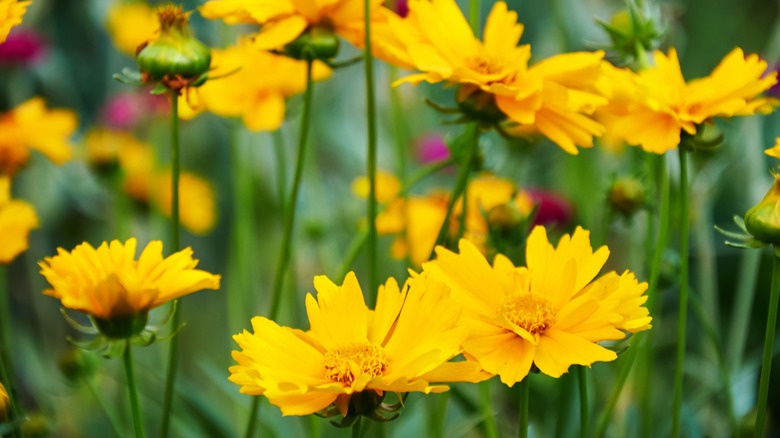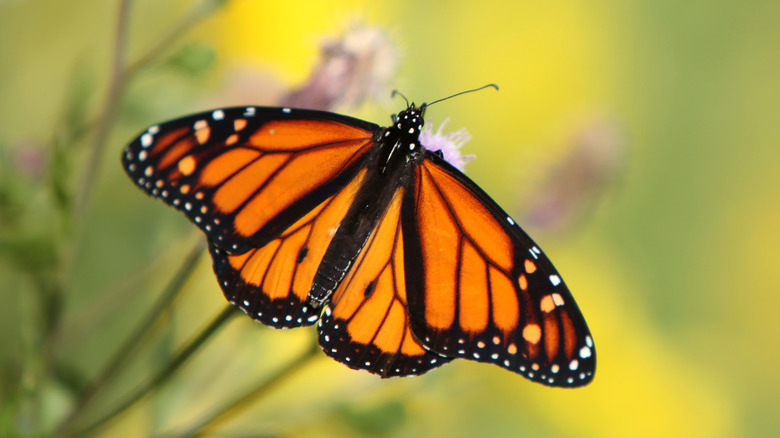This Wildflower Is An Easy To Propagate Perennial For Beginner Gardeners
The beginning of your gardening journey is always tough. There are a lot of things to learn about plant care, and while killing your first few plants is a right of passage, it can quickly become discouraging if it continues. Because of this, beginner gardeners are recommended to focus on cultivating easy-to-grow plants. This will help create small wins, ensuring you avoid getting demoralized or thinking you don't have a green thumb. If you're looking for such a plant, the wildflower called lanceleaf coreopsis, also known as lanceleaf tickseed, is a great contender.
This cheerful yellow flower is extremely low maintenance. It's easy to cultivate from seed, and once established, it self-seeds at the end of the season, rewarding you with more blooms the following year with no effort on your part. Plus, it's super tolerant of mistakes. It won't wilt on you if you over-water it or forget to give it a drink. It can also grow relatively well in poor soil, which is perfect for those who don't quite understand how to amend their dirt or fertilize their garden beds. Here is a closer look at why this is a great example of a colorful flower that is perfect for beginner gardeners.
Lanceleaf coreopsis is super easygoing
Lanceleaf coreopsis is one of the easiest plants to grow for beginner gardeners. When growing from seed, it's enough to drop them on top of the dirt and call it a day. However, if you want to practice your sowing skills, you can also plant them 1/16 inch deep in the ground. They're also pretty forgiving of when you plant them. You can sow in early spring, or if you missed the window, you can plant in the fall after the growing season has ended. Coreopsis is also very easygoing about location. You can plant the seeds in everything from loamy to sandy to rocky to clay soil, and the flowers will grow in everything from direct sunlight to partial shade.
The plant is also pretty drought-tolerant, meaning the blooms won't wither away if you forget to water them for a week or two. This is great for nervous beginners who are still trying to figure out how much water and how often they should be saturating their garden beds. However, if you're unsure how much water it needs, it's better to underwater than overwater this particular wildflower since it's susceptible to root rot. Once a week should be sufficient. Once the season is over and the blooms begin to fall back, you can either allow it to self-seed or help it along by splitting it apart. The wildflowers grow in clumps, and in the fall, you can divide the clumps and replant them.
Added perks of growing this wildflower
Lanceleaf coreopsis is also an exciting beginner plant to grow because it attracts pollinators. If you're looking for ways to attract butterflies to your garden, this is a great first step. Monarch and buckeye butterflies love to land on their big yellow faces and drink their nectar. It can also be a host plant for your neighborhood's silvery checkerspot butterflies, which might use it to lay their eggs. Butterflies are attracted to these flowers because of their bright yellow coloring. Bold colors advertise to pollinators that there is delicious nectar inside, so they make a direct line for them.
Another added benefit is that lanceleaf coreopsis is deer- and rabbit-resistant. As anyone who lives next to the woods knows, having these friendly animals roaming your neighborhood means you can't indulge in too much landscaping. If you do, it will just end up as a buffet meal for these woodland critters. However, these flowers won't attract them, making them a viable choice for planters or front landscaping.


